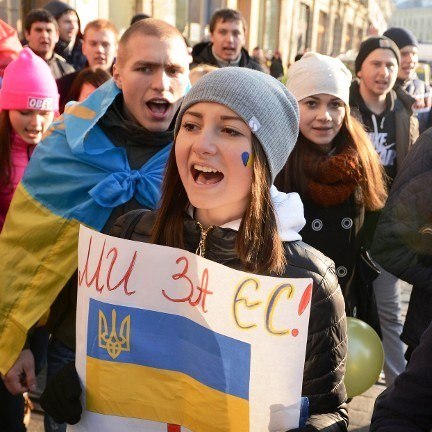Among the most notorious aspects of the current debate on Ukraine are the multiple parallels between the ongoing developments within the country and the series of “big movements” that have shaped the European neighborhood over the past several decades. Considering the situation in Ukraine within the scope of these larger cycles of transformation is vitally important in order to avoid country-specific explanations and also to understand the wider context of the current Ukrainian transition.
The first reference point in history to consider is the period from 1989-1991 and the disintegration of the Soviet Union. The recent demolition of many statues of Lenin all over Ukraine attests to the widespread intention among protestors to ultimately finalize the still unfinished de-communization of their country. These symbolic, yet still deeply political, gestures contain a strong anti-imperial impulse widely shared among Ukrainians today.
Parallels with what happened between 1989 and 1991 also evoke other associations related to the flimsy statehood of countries which dealt with internal ethnic and political splits, with the breakup of Yugoslavia and Czechoslovakia serving as the best illustrations of such occurrences within Europe. Ukraine, however, should be more concerned about the alarming comparisons with Moldova and Georgia, both of which lost portions of their territories in the process of their post-Soviet transformations. What makes Crimea comparable to Transnistria or Abkhazia is the resilience of the Soviet-style mentality and lifestyles in these territories which stand on Russia’s geopolitical periphery. This is exactly why Russia appears to support such separatists which reside across its borders.
Of course, parallels with the 1991 upheavals require a closer look at the status of Russia as a successor to the Soviet Union. This provision stretched far beyond the sphere of legality and had obvious political repercussions. The genealogy of Russian president Vladimir Putin's neo-imperial project dates back to the instrumentalization of the idea of succession, which was understood by Moscow as the legitimation of its special role in Russia’s “near abroad.” It is hard to say how seriously Moscow takes other legal norms of the initial post-Soviet years, in particular the Budapest Memorandum of 1994 in which Russia together with the US and UK assumed the role of acting as the international guarantors of Ukraine's independence. In fact, by directly supporting separatism in Crimea, Russia is intentionally trying to rewrite the whole post-1991 arrangements on Ukraine and is directly challenging the great power management-type of agreements of which Moscow has traditionally been in favor.
What may invalidate comparisons to the events of 1989-1991 is the fact that the Europe of today is deeply divided over its policy on Eastern Europe. On the one hand, dozens of people in Kyiv have given their lives to bring their country closer to Europe and it would be unthinkable for EU politicians to ignore the situation. On the other hand, the EU lacks effective instruments for balancing Russia, which has backfired through accusations of inaction and even betrayal of Ukraine.
With this in mind, it is appropriate to bring up a second reference point in today's debate on the situation in Ukraine: the proverbial Orange Revolution of 2004. Indeed, the people demonstrating on Maidan in 2014 were protesting against the same type of oppressive and corrupt regime and came up with a similar agenda for change as in 2004. International reactions to the events of 2004 and 2014 were also similar in that a group of ardent proponents for Ukraine's Europeanization in the West were countered by Russia's intransigent reaction. Yet, as the NATO Bucharest summit of 2008 made clear, the West (and particularly Europe) has been divided over its Russia policy and lacked any unified resolve to institutionally integrate Ukraine, even during the time when the country had a pro-Western government. In light of the de-facto annexation of Crimea by Moscow, it has become clear that the West is paying a dear price for adopting the strategy of trying to compromise with Russia. At the same time, recent examples suggest that while Russia can take away territories from neighboring countries, it does not mean that Russia cannot prevent Tbilisi or Chisinau from moving closer to Europe.
Finally, a third reference point to consider is the Arab Spring. This context is particularly uncomfortable for Ukraine since it implicitly associates the country with Northern Africa and the Middle East, portraying Ukraine as allegedly being closer to these regions than with Europe. Those who have chosen to compare Ukraine with Syria should realize that they (perhaps unintentionally) put into question the gist of the Ukrainian protest, which of course has always been its European normative core.
Ultimately, the narrative of Ukraine's transformation from the fall of the Soviet Union through the Orange Revolution and up to the troubles of today is to a large extent the story of Europe itself. In 1991, Europe was not only an undeniable magnet for eastern European states, but it also managed to successfully assist them in completing their process of integration. The color revolutions, meanwhile, have given much more controversial results: the EU lacked due influence over both Yuschenko and Saakashvili, and the outcomes of their presidencies ultimately strayed far from initial expectations. In 2014, we face a Europe which is divided domestically and is facing a potential confrontation with Russia, something which EU member states would like to avoid. Taking a closer look at these historical cycles indeed provides us with some good food for thought.









